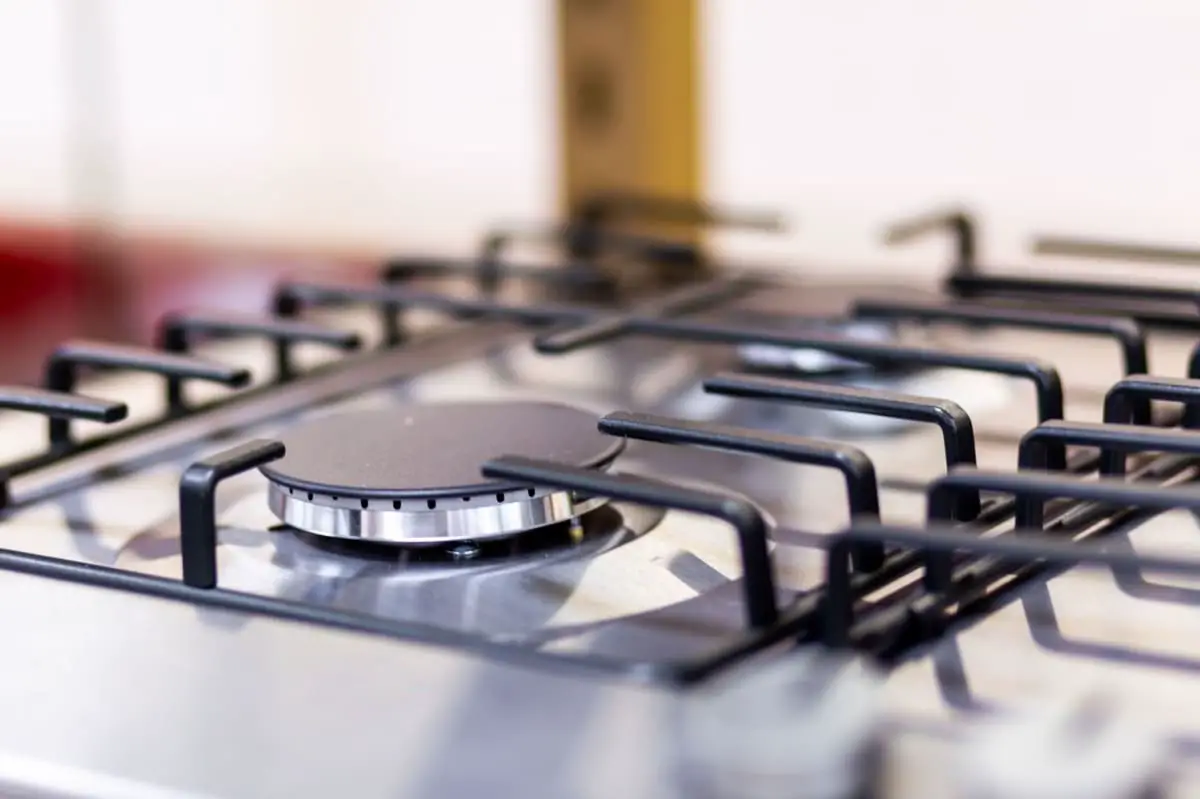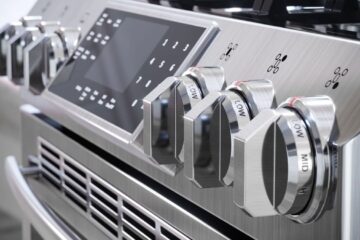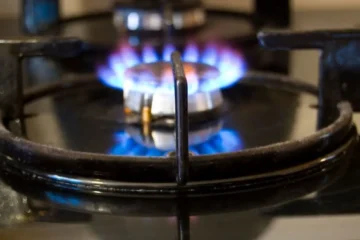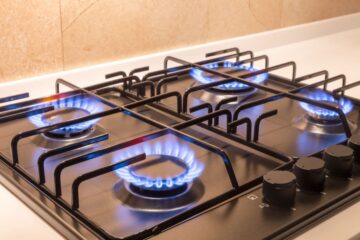When designing a kitchen, one of the important elements to consider is the backsplash. The backsplash is not only functional, but it can also add style and personality to a kitchen. However, when it comes to deciding where to stop the backsplash behind the stove, there are different opinions and options.
According to various sources, the best place to stop a backsplash behind a stove is in line with the upper cabinets, along the edges of the countertop, and behind the stove. These areas are important to be covered to ensure that the backsplash has a complete look to it. It is also recommended to stop the backsplash where there will be food and water splatter, but not where it can’t be seen.
It is important to consider the layout of the kitchen and the design of the cabinets and countertops when deciding where to stop the backsplash. In some cases, a natural stopping point may be a wall, a window, or a cabinet edge. It is also possible to use tile edging trim or bullnose tile to create a distinct edge for the backsplash. Ultimately, the decision of where to stop the backsplash behind the stove depends on personal preference and the overall design of the kitchen.
Determining the Height of the Backsplash
When it comes to determining the height of the backsplash behind the stove, there are a few things to consider. The height of the backsplash can impact the overall look of the kitchen, as well as its functionality. Here are some factors to keep in mind when determining the height of the backsplash.
Standard Height
The standard height for a kitchen backsplash is typically 18 inches from the countertop to the bottom of the upper cabinets. This height offers protection for the wall behind the stove while also providing a cohesive look throughout the kitchen. For most kitchens, this standard height is sufficient.
Higher Than Standard
In some cases, it may be necessary to install a backsplash that is higher than the standard height. For example, if the stove has a higher BTU output, it may be necessary to install a taller backsplash to protect the wall from heat damage. Additionally, if the homeowner is taller than average and tends to splatter food while cooking, a taller backsplash can provide added protection.
Lower Than Standard
If the homeowner has a smaller kitchen or wants to create a more open feel, a lower backsplash may be appropriate. A backsplash that is lower than the standard height can create the illusion of more space and make the kitchen feel less cluttered. However, it’s important to note that a lower backsplash may not provide as much protection for the wall behind the stove.
Where To Stop Backsplash Behind Stove?
When installing a backsplash in a kitchen, one of the most common questions is where to stop the backsplash behind the stove. There are several factors to consider when deciding where to end the backsplash, including the layout of the kitchen, the style of the backsplash, and personal preference.
One of the main considerations when deciding where to stop the backsplash is the upper cabinets. It is generally recommended to stop the backsplash in line with the upper cabinets, as this creates a clean, finished look. This is particularly important in U- or L-shaped kitchens where the uppers end over a peninsula, as ending the backsplash in line with the uppers creates a crisp vertical line.
Another important factor to consider when deciding where to end the backsplash is the countertop. It is recommended to end the backsplash along the edges of the countertop, as this provides a complete look to the backsplash. This is particularly important in areas where there will be food and water splatter, such as behind the stove.
When installing a backsplash behind the stove, it is important to consider the style of the backsplash. A backsplash that is too busy or intricate may be overwhelming when installed behind the stove, whereas a simple and clean backsplash may look too plain. It is important to choose a backsplash that complements the overall style of the kitchen and provides a cohesive look.
In summary, when deciding where to stop the backsplash behind the stove, it is recommended to end the backsplash in line with the upper cabinets, along the edges of the countertop, and behind the stove. It is also important to consider the style of the backsplash and choose a design that complements the overall look of the kitchen.
Materials for Backsplash
When it comes to backsplash materials, there are many options to choose from. Each material has its own unique characteristics and benefits. In this section, we will explore some of the most popular materials for backsplashes.
Tile Backsplash
Tile backsplashes are a classic choice for kitchens. They come in a wide variety of colors, shapes, and sizes, making it easy to find the perfect match for your kitchen. Ceramic and porcelain tiles are the most common materials used for tile backsplashes. They are durable, easy to clean, and resistant to heat and moisture. Glass tiles are another popular option for a modern and sleek look.
Metal Backsplash
Metal backsplashes are a great option for a contemporary or industrial-style kitchen. Stainless steel is the most popular metal used for backsplashes because it is durable, easy to clean, and resistant to heat and moisture. Copper and brass are also popular choices for a unique and stylish look.
Glass Backsplash
Glass backsplashes are a modern and sleek option for a kitchen. They come in a variety of colors and patterns, and can be customized to fit any kitchen design. Glass backsplashes are easy to clean and resistant to heat and moisture. They are also a great option for small kitchens, as they can make the space feel larger and more open.
Stone Backsplash
Stone backsplashes are a luxurious and elegant option for a kitchen. Granite and marble are the most popular stones used for backsplashes because they are durable and resistant to heat and moisture. They come in a variety of colors and patterns, making it easy to find the perfect match for your kitchen design. Stone backsplashes do require some maintenance, such as sealing, to keep them looking their best.
Design Options for Backsplash
When it comes to designing a backsplash behind the stove, there are several design options to choose from. The design should complement the overall kitchen design and enhance the visual appeal of the space. Here are some design options to consider:
Matching the Countertops
One design option is to match the backsplash with the countertops. This creates a cohesive look and ties the design elements of the kitchen together. For example, if the countertops are made of granite, a granite backsplash can be installed behind the stove. This design option works well for kitchens with a minimalist design and neutral color palette.
Contrasting the Countertops
Another design option is to create contrast between the backsplash and countertops. This can be achieved by using a different material or color for the backsplash. For example, if the countertops are made of white marble, a black or gray backsplash can be installed behind the stove. This design option works well for kitchens with a bold design and color palette.
Creating a Focal Point
A backsplash behind the stove can also be used to create a focal point in the kitchen. This design option works well for kitchens with a unique design element or feature that can be highlighted with the backsplash. For example, a mosaic tile backsplash can be installed behind the stove to create a focal point. This design option works well for kitchens with a modern or eclectic design.
When choosing a design option for the backsplash behind the stove, it is important to consider the overall design of the kitchen. The backsplash should complement the design elements of the kitchen and enhance the visual appeal of the space. By considering these design options, homeowners can create a backsplash that is both functional and beautiful.
Installation Process
Installing a backsplash behind the stove is a great way to protect the wall from food and water splatters. Here are the steps to follow for a successful installation process.
Preparing the Wall
Before installing the backsplash, it is important to prepare the wall. Start by cleaning the wall with soap and water to remove any dirt or grease. Then, sand the wall to create a rough surface that will help the adhesive stick. If there are any holes or cracks in the wall, fill them with spackle and let it dry completely before sanding.
Installing the Backsplash
Once the wall is prepared, it’s time to install the backsplash. Measure the area where the backsplash will go and cut the tile accordingly. Apply the adhesive to the wall using a notched trowel, and then press the tiles into place. Use tile spacers to ensure even spacing between the tiles. Repeat this process until the entire area is covered.
Grouting
After the adhesive has dried, it’s time to grout the tiles. Mix the grout according to the manufacturer’s instructions and apply it to the tiles using a rubber float. Be sure to work the grout into the gaps between the tiles. Once the grout is applied, wipe away any excess with a damp sponge. Let the grout dry for 24 hours before moving on to the next step.
Sealing
The final step is to seal the grout to protect it from staining and moisture. Apply the sealer according to the manufacturer’s instructions, using a paintbrush or roller. Be sure to cover the entire surface, including the edges and corners. Let the sealer dry completely before using the stove or cleaning the backsplash.
Maintenance and Cleaning
When it comes to maintaining and cleaning the backsplash behind the stove, there are a few things to keep in mind. First and foremost, it’s important to wipe down the backsplash regularly to prevent grease and grime buildup. This can be done using a damp cloth or sponge and a mild cleaning solution.
For tougher stains or buildup, there are a variety of cleaning methods that can be used. According to a Kitchn article, the Dawn PowerWash method is an effective way to remove grease from kitchen backsplashes. Simply spray the backsplash with the Dawn PowerWash, let it sit for two minutes, and then wipe it with a dry microfiber rag. Follow up with a damp cloth to rinse away any soap residue.
It’s also important to consider the materials used for the backsplash when it comes to cleaning. Stone or stone-type materials are typically more heat-resistant and easier to clean than other materials, such as wall paneling. If using wall paneling for the backsplash, it’s important to keep cleaning in mind, especially if it has small grooves that can trap grease and grime.
Incorporating backsplash cleaning into a regular cleaning routine can help prevent buildup and make cleaning easier in the long run. This can be as simple as wiping down the backsplash after cooking or incorporating it into a daily or weekly cleaning schedule. By taking these steps, homeowners can keep their backsplash looking clean and beautiful for years to come.
Conclusion
In conclusion, determining where to stop a backsplash behind a stove is an important decision that can impact the overall look and feel of a kitchen. It is important to consider the layout of the kitchen and the natural stopping points that exist, such as the end of the cabinets and countertops, the edge of the wall, a window, or the ceiling.
The key is to find a natural stopping point that creates a cohesive and complete look. In most cases, the best place to stop a backsplash is in line with the upper cabinets, along the edges of the countertop, and behind the stove. These are areas that need to be covered to make sure the backsplash has a complete look to it.
It is also important to consider the height of the backsplash. When tiling a kitchen backsplash behind a stove, the best practice is to continue the tiles down the wall a minimum of one full course below the countertop height. This ensures that the area behind the stove is fully covered and protected from splatters and spills.
Overall, finding the right stopping point for a backsplash behind a stove requires careful consideration of the layout of the kitchen and the natural stopping points that exist. By following these tips and guidelines, homeowners can create a beautiful and functional kitchen that meets their needs and preferences.



